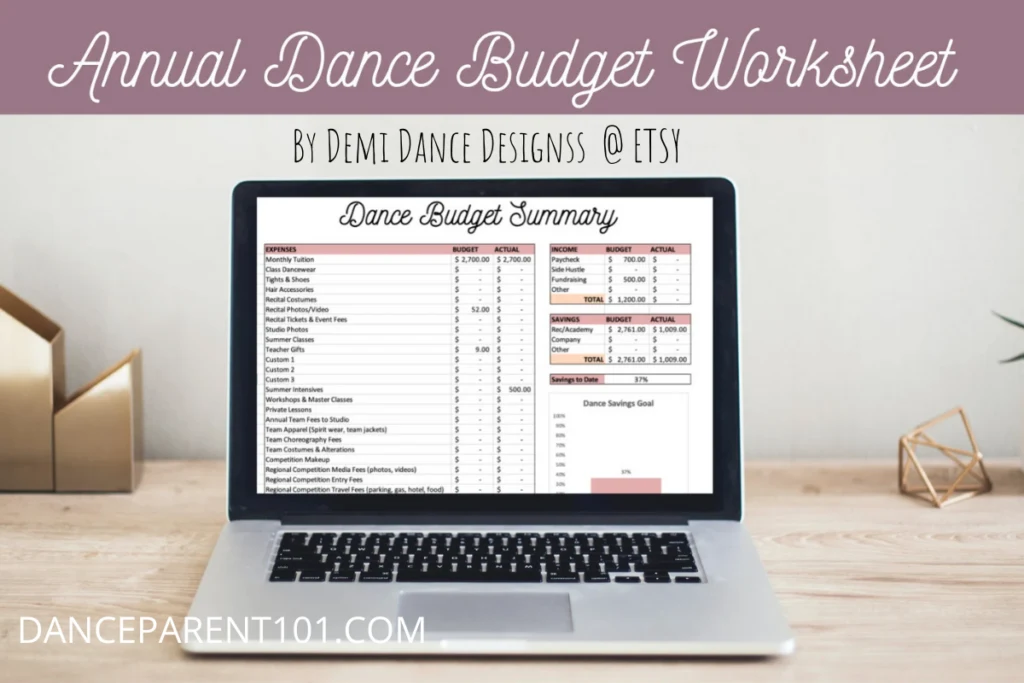
Now that your dancer has made your studio’s competition team, it’s time for your role as a parent to start: paying the bills! In addition to a serious time commitment for both your family and dancer, competitive dance usually comes with a financial investment that requires ample planning.
The simplest way to cover the cost of competitive dance, that includes choreography, costumes, classes, entry fees, and travel is to make a budget. Even better, budgeting for competition a year in advance will help you save more accurately and relieve stress.
With a little planning, you can set up a budget that is reasonable, attainable, and most importantly is as low-stress as possible! Keep reading to see how.
How do I budget for dance a year ahead of time?

The simplest answer as to how you can budget a year in advance is to identify your costs for the next dance season, then divide the total over 12 months so you can save at a reasonable rate.
That way, instead of trying to come up with thousands of dollars all at once, you can save a few hundred dollars every month until you reach your goal.
Keeping in mind that some costs might fluctuate, this type of budgeting will help keep everyone in your family on the same page and give you a reasonable goal that doesn’t feel overwhelming.
Identifying your upcoming costs is an important step in developing a realistic budget, but where do you start?
How many routines does your dancer want to do?
One of the easiest ways to start budgeting is to identify how many dances or routines your dancer wants to compete in next season. Since different types of routines can fluctuate anywhere from hundreds to thousands of dollars, it’s important to nail down how many so you can get a clear picture of how much you need to budget for.
Each routine will have a number of factors that give it a price tag, such as choreography, cleaning sessions, entry fees that may include Title and costumes.
Normally, solos are the most expensive, followed by duos/trios, small groups, large groups and productions/lines. The more routines your dancer does, the more you as a dance parent will need to account and save for.
Once you’ve talked with your dancer and identified the total number of routines you are willing to pay for, you have a starting point for your budget.

What other types of dance expenses do I need to budget for?
Like recreational dance, competitive dance comes with many extraneous expenditures throughout the year. When creating your budget, it can be helpful to think in terms of categories.
For example, travel costs are more than just gas or plane ticket to get to competitions and nationals. You’ll also need to account for parking fees, hotels, eating out, and activities.
When factoring in class expenses like shoes and clothing, details like tights, replacement shoes, bobby pins, and spirit wear should all go into your budget.
Don’t forget about seasonal costs, like summer intensives, audition fees, holiday gifts for teachers, recital tickets, and your annual dance convention.
What are some ways to save money to put towards competitive dance?
In addition to setting aside a designated amount from your regular paycheck, there are other ways you can save for competition dance that make the process easier.
Many dance parents assist at their dancer’s studios doing a variety of tasks like stoning costumes, working the front desk, or even cleaning. These options can either result in a discount on classes (which means you can put that money towards company expenses) or an actual paid job.
It’s also very common to take on part-time work, like freelancing, Uber driving, or working for Instacart. Parents who do this put all their earnings toward dance, which can help relieve their monthly savings burden. This is what many people refer to as a “side hustle.”
Finally, fundraising can greatly help cover the costs of dance and there are plenty of options when it comes to picking one that works best for you. Many studios run their own fundraisers, like selling flowers and pies during the holidays, but you can also come up with your own.
Stuck on ideas?
You can get more ideas for dance fundraisers here.
How can I track my dance budget?
There are a number of avenues for tracking your budget, but a simple one is to utilize a spreadsheet that tracks upcoming expenditures.
This annual dance budget spreadsheet from Demi Dance Designs is a multi-page Excel workbook (that works on Google Sheets, too!) that breaks down costs in a variety of areas, such as recreational dance, company dance, travel costs, private lessons, enrollment fees and more.
Once you figure out your expenses, routines, and income, you simply pop the information into the spreadsheet and it will automatically determine your monthly savings goals and you’re on your way to saving a year in advance.
Competition dance is a wonderful investment for your dancer, where they’ll develop new skills, improve their technique, maturity, perseverance, and much more. If you’d like more resources on competition dance, read below:
Other Articles You Might Like to Read
Check us out on Pinterest

















